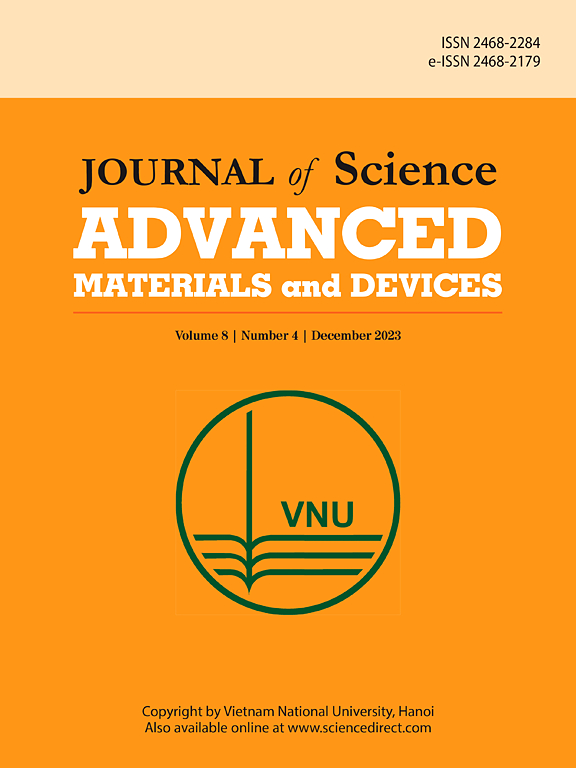Comparative study of CaFe2O4 with nanocomposites CaFe2O4@SiO2 and the effect of silica shell thickness on their physical and magnetic properties
IF 6.8
3区 材料科学
Q1 MATERIALS SCIENCE, MULTIDISCIPLINARY
Journal of Science: Advanced Materials and Devices
Pub Date : 2025-04-06
DOI:10.1016/j.jsamd.2025.100886
引用次数: 0
Abstract
In this paper, a comparison between CaFe2O4 (CFO) nanoparticles and CaFe2O4@SiO2 nanocomposites (CFO@Si) with different amounts of (TEOS) and the effect of silica shell thickness on the physical and magnetic properties of these materials has been made. Nanoparticles (CFO) were first synthesized using the self-combustion sol-gel method, and then their surface was coated using silica and the Stöber sol-gel method. The resulting nanoparticles and nanocomposites were characterized using XRD, FESEM, TEM, AFM, FTIR, BET, BJH, and VSM analyses. The results showed that increasing the TEOS concentration resulted in a thicker silica shell, which increased the dispersion, improved the stability, and prevented the aggregation of the nanocomposite (CFO@Si) compared to the nanoparticles (CFO). It was also found that the magnetic properties of the nanocomposite (CFO@Si) decreased with increasing thickness of the silica shell compared to the nanoparticles (CFO). Consequently, this paper highlights the critical role of TEOS concentration and silica shell thickness in improving the physical and magnetic properties of the nanocomposite (CFO@Si) compared to the nanoparticles (CFO). These findings can help improve the applications of magnetic nanocomposites in various scientific and industrial fields.
CaFe2O4与纳米复合材料CaFe2O4@SiO2的对比研究及二氧化硅壳厚度对其物理和磁性能的影响
本文比较了不同TEOS用量的CaFe2O4 (CFO)纳米粒子和CaFe2O4@SiO2纳米复合材料(CFO@Si)的物理和磁性能,以及二氧化硅壳厚度对材料物理和磁性能的影响。首先采用自燃溶胶-凝胶法合成纳米颗粒(CFO),然后采用二氧化硅和Stöber溶胶-凝胶法对其表面进行包覆。采用XRD、FESEM、TEM、AFM、FTIR、BET、BJH和VSM等方法对纳米颗粒和纳米复合材料进行了表征。结果表明,与纳米颗粒(CFO)相比,TEOS浓度的增加使纳米复合材料(CFO@Si)的分散性增强,稳定性提高,并阻止了纳米复合材料(CFO@Si)的聚集。与纳米颗粒(CFO)相比,纳米复合材料(CFO@Si)的磁性能随二氧化硅外壳厚度的增加而下降。因此,本文强调了与纳米颗粒(CFO)相比,TEOS浓度和二氧化硅壳厚度在改善纳米复合材料(CFO@Si)的物理和磁性能方面的关键作用。这些发现有助于提高磁性纳米复合材料在各种科学和工业领域的应用。
本文章由计算机程序翻译,如有差异,请以英文原文为准。
求助全文
约1分钟内获得全文
求助全文
来源期刊

Journal of Science: Advanced Materials and Devices
Materials Science-Electronic, Optical and Magnetic Materials
CiteScore
11.90
自引率
2.50%
发文量
88
审稿时长
47 days
期刊介绍:
In 1985, the Journal of Science was founded as a platform for publishing national and international research papers across various disciplines, including natural sciences, technology, social sciences, and humanities. Over the years, the journal has experienced remarkable growth in terms of quality, size, and scope. Today, it encompasses a diverse range of publications dedicated to academic research.
Considering the rapid expansion of materials science, we are pleased to introduce the Journal of Science: Advanced Materials and Devices. This new addition to our journal series offers researchers an exciting opportunity to publish their work on all aspects of materials science and technology within the esteemed Journal of Science.
With this development, we aim to revolutionize the way research in materials science is expressed and organized, further strengthening our commitment to promoting outstanding research across various scientific and technological fields.
 求助内容:
求助内容: 应助结果提醒方式:
应助结果提醒方式:


